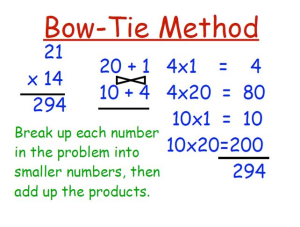Viewing: Class Updates
November 24, 2015
Unit 3 Math – Multiplication Strategies
Hello everyone,
Over the past few weeks we have been working on several different strategies for multiplying, specifically multiplying 2-digit by 2-digit numbers. We will be finishing this unit today (November 24th), and we will review after Thanksgiving weekend, before their assessment. To help with this review, Mr. Moss and I thought it would be helpful to post some videos of the different strategies.
The first lesson was to estimate numbers before multiplying them so that you can just multiply the basic math fact and then add the zeros at the end. Here is a video to help explain that a bit better:
The next day, we worked on using the area model to actually do 2-digit by 2-digit multiplication. Think of taking a rectangle are breaking it apart into parts, finding the area of each rectangle and then adding it all back together. Here’s another video for that method:
After that, we worked on using partial products to multiply. Basically, doing the same thing as the area model, but without the box. Here’s a picture to help:
And, of course, another video to help:
Finally, we got to the standard method of multiplication. We started by looking into why this method works, something even most adults are unsure of. We broke apart the multiplication problem again, but instead of breaking into four parts like with the partial products method, we broke it into two. Students know how to do 2-digit by 1-digit multiplication well by now. They also know how to multiply 2-digits by 2-digits as long as one of the numbers ends in a zero. So we took apart the bottom number, for example:
23 became 23 and 23
x 34 x 30 x 4
Students can much more easily do 23 x 30 and 23 x 4 than they can do 23 x 34.
Once they found the answer to both parts of the broken up problem. We added them together.
Finally, we learned how to do it all together – the same way we all learned – with regrouping numbers. Here’s a video to better explain that (2-digit by 2-digit with regrouping starts at 3:20)
We want students to be familiar with all 3 methods of multiplication, but they can use whichever method they like best when doing multiplication from here on out. Today, we discussed how everyone has different preferences when it comes to math and that it’s ok for them to pick their favorite method when doing multiplication.
Hopefully this wasn’t too confusing for everyone; it’s harder to explain in writing than it is in person. But the videos should do a pretty good job of giving a visual to my rambling.
Enjoy!
~ Mr. Walmer
Posted in Class Updates|By Brendan Walmer
November 17, 2015
Circus Week and Character
 We’re midway though a terrific week in room 209! On Monday, we got to watch an AMAZING performance by the National Circus Project. (I live-tweeted photos and videos from the circus.) What was particularly incredible was that the performance was an introduction for the fourth graders. Since that performance your fourth grader has been working to master some amazing skills that they first saw performed in Monday’s show. I’ve had the opportunity to see a few of the different performances, and I’m really impressed by how quickly and thoroughly the kids are mastering these skills! On Friday afternoon, fourth graders will perform for the whole school, and I hope you’re planning on coming to the kids’ evening performance on Friday night at 6:30pm. All the fourth grade teachers will be there for the fun, and I can’t wait to see the kids show all they’ve learned.
We’re midway though a terrific week in room 209! On Monday, we got to watch an AMAZING performance by the National Circus Project. (I live-tweeted photos and videos from the circus.) What was particularly incredible was that the performance was an introduction for the fourth graders. Since that performance your fourth grader has been working to master some amazing skills that they first saw performed in Monday’s show. I’ve had the opportunity to see a few of the different performances, and I’m really impressed by how quickly and thoroughly the kids are mastering these skills! On Friday afternoon, fourth graders will perform for the whole school, and I hope you’re planning on coming to the kids’ evening performance on Friday night at 6:30pm. All the fourth grade teachers will be there for the fun, and I can’t wait to see the kids show all they’ve learned.
 Curious why we’re working on the circus in school? Well, besides the fact that it’s AWESOME (C’mon, don’t we all wish we’d had a similar opportunity when we were kids?), Circus Week has given the kids an amazing opportunity to learn teamwork, perseverance as they learn a new skill, problem solving, and so much more. These are definitely key life skills that will influence their academic success now and in the future. Additionally, our school’s character focus this month and next month is on the pillar of fairness. This is a terrific time for us to have the circus, since we’re able to discuss questions of fairness, such as who got their first choice for parts in the circus, why some roles are harder or easier than others, etc. In class, we have a set meaning of the word fairness. (Ask your child if he or she remembers it!) We say: Fair doesn’t mean that everyone gets the same thing. Fair means that everyone gets what he or she needs. It may not be the most elegant definition, but it works for us! In Circus Week, this means that some kids may have an easier or harder skill to practice, and that’s fair, because everyone got a skill that’s right for them.
Curious why we’re working on the circus in school? Well, besides the fact that it’s AWESOME (C’mon, don’t we all wish we’d had a similar opportunity when we were kids?), Circus Week has given the kids an amazing opportunity to learn teamwork, perseverance as they learn a new skill, problem solving, and so much more. These are definitely key life skills that will influence their academic success now and in the future. Additionally, our school’s character focus this month and next month is on the pillar of fairness. This is a terrific time for us to have the circus, since we’re able to discuss questions of fairness, such as who got their first choice for parts in the circus, why some roles are harder or easier than others, etc. In class, we have a set meaning of the word fairness. (Ask your child if he or she remembers it!) We say: Fair doesn’t mean that everyone gets the same thing. Fair means that everyone gets what he or she needs. It may not be the most elegant definition, but it works for us! In Circus Week, this means that some kids may have an easier or harder skill to practice, and that’s fair, because everyone got a skill that’s right for them.
Posted in Class Updates|By Jon Moss
October 14, 2015
Reviewing Math Skills
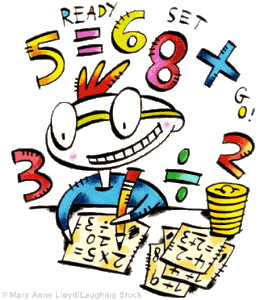 In late September, students completed the first math assessment. Normally, we strive to score these and promptly send them home for you to review, sign, and return to us. This time, however, we have intentionally held off on doing so. We found that there were several items on the assessment that were challenging to students, and we wanted to review many of these with the class. For the past few weeks, we’ve been reviewing skills with the whole class that were challenging for a large group of students. Mr. Walmer and I have also been pulling students to address skills that are best taught by repeated practice in small groups, such as rounding, multi-digit subtraction with regrouping, and standard form/word form/expanded form. As you receive and review the assessments, please rest assured that we are working with your fourth grader on any areas that he or she struggled with.
In late September, students completed the first math assessment. Normally, we strive to score these and promptly send them home for you to review, sign, and return to us. This time, however, we have intentionally held off on doing so. We found that there were several items on the assessment that were challenging to students, and we wanted to review many of these with the class. For the past few weeks, we’ve been reviewing skills with the whole class that were challenging for a large group of students. Mr. Walmer and I have also been pulling students to address skills that are best taught by repeated practice in small groups, such as rounding, multi-digit subtraction with regrouping, and standard form/word form/expanded form. As you receive and review the assessments, please rest assured that we are working with your fourth grader on any areas that he or she struggled with.
The final question on the assessment was a particularly challenging problem, in part, because it was not written in the most clear way. Many students lost points on this one question, and because it accounted for 9 points on the 36 point assessment. So you can see how struggling on this one question could dramatically impact students’ individual scores. For that reason, we strongly encourage you to look at your son or daughter’s performance on individual questions, rather than focusing on the percentage score (which, in all candor, tended to be lackluster for students throughout the class). Additionally, Mr. Walmer taught a great lesson yesterday that reviewed that challenging final question. After practicing the skill in class, students completed a similar problem, and we are so pleased that ALL students improved on their score from the assessment. Those reteaching worksheets are stapled to the end of the students’ assessments.
We ask that you take time this week to review your child’s performance on the math assessment, sign it, and PLEASE SEND IT BACK TO SCHOOL. Once again, we encourage you to examine how your child did on individual problem-sets (in rows, with the row score on the left side of the page) in order to look for strengths and weaknesses. Please don’t dwell on the percentage score, which was (for many students) pulled down by one challenging question at the end of the assessment.
Posted in Class Updates|By Jon Moss
October 4, 2015
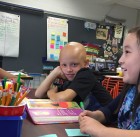
Learning to Collaborate
A big focus in Room 209 in learning to collaborate on tasks and explain your thinking. People often think that collaboration helps during challenging activities, and that’s certainly true. But we also have students collaborate even when they could easily complete a task independently, because the process of sharing ideas, considering other points of view, and discussing strategies and options helps students to think more deeply about a given topic. It also helps to develop collaboration skills that are, of course, critical life skills.
Last week, for example, we began working on narrative elements by focusing on the setting of stories. We read, as a class, The Purple Coat (one of my all-time favorites) and identified clues about the setting. I then modeled the process of writing a short-answer response (SAR) to identify and explain the setting of the story. We looked at the SAR Checklist as a way of remembering the elements of a successful short-answer response. Students then collaborated with one or two partners to write a similar response about The Josefina Story Quilt, which students read for homework on Monday or Tuesday. We shared some of these responses (from groups that volunteered) and discussed strengths and weaknesses, using the new fourth grade SAR rubric. (Stay tuned for some resources for parents!) On Friday, students worked independently to write their own SAR about the setting of A Chair for My Mother (which is arguably my all-time favorite children’s book). This process of gradual release supports students as we move from teacher-led learning to group work to independent application. You’ll see a lot of this style of learning this year, especially in the next few weeks as we address the remaining narrative elements.
Posted in Class Updates|By Jon Moss
September 25, 2015
Checking Your Child’s Spelling Assessment Results
Our first online spelling assessment went perfectly! Kids were able to complete the assessment at their own pace, and students seemed to enjoy the process of practicing their words online over the week. Because the assessments were completed online, there are not hard copies for me to send home. To check your child’s assessment results each week, have him or her log into Spelling City. On the top-right corner of the screen, click on My Records. Then, locate the spelling list for which you want to check the results, or the activity, or the date. Click on the activity name to see the results of the assessment. Please feel free to email me with any questions! Enjoy your weekend!
Posted in Class Updates|By Jon Moss
September 21, 2015
Spelling Words Starting Today
We are excited to launch our spelling program this week! Each week, the spelling list will be generated from the week’s lessons. Words on the list might be vocabulary terms from the week’s lessons, words that came up in the course of discussions in class, or words that are being introduced in preparation of upcoming lessons. We will also have weekly states and capitals to practice.
 Last year, my class piloted the use of a program called Spelling City for practicing spelling words and taking spelling assessments. This year, the pilot has expanded to all of fourth grade, and all five classes are using Spelling City for these purposes. Every Monday, students will log in to Spelling City to access their spelling list. The site has many apps and games to help students learn their words. Because their spelling list comes from class discussions and lessons, this system will also help them to practice the meanings of the words.
Last year, my class piloted the use of a program called Spelling City for practicing spelling words and taking spelling assessments. This year, the pilot has expanded to all of fourth grade, and all five classes are using Spelling City for these purposes. Every Monday, students will log in to Spelling City to access their spelling list. The site has many apps and games to help students learn their words. Because their spelling list comes from class discussions and lessons, this system will also help them to practice the meanings of the words.
On Fridays, students will take their spelling assessments on Spelling City. The system will read them the words aloud, use them in sentences, and allow students to spell the words. The advantage of this system is that students can work at their own pace, rather than struggling if the words are coming too quickly. Also, because the assessments are self-grading, students receive immediate feedback about their performance.
Each week, your child should come home and be able to explain why certain words made it on the list (unless they are words being introduced in preparation for an upcoming lesson). Students are encouraged to use Spelling City to play some of the games in order to practice their words in a more enjoyable manner. They are NOT required to complete all the games, despite what the “assignment” might imply. (There may be days in which I will assign a specific game, but I will share that explicit assignment in class.)
In the weeks to come, we will improve our routines with using Spelling City, and we will begin to place more emphasis on the meanings of the words, in addition to the spelling. Coming home today, you will find a letter that explains more about the program and provides you with your child’s username and password. If you have any questions, please feel free to email me!
Posted in Class Updates|By Jon Moss
September 8, 2015
Curriculum Night Video
I enjoyed seeing many families at Thursday’s curriculum night. If you were unable to attend, you can watch the recording of the session online (below). There were no handouts, since all materials are available on our class website.
Posted in Class Updates|By Jon Moss
August 28, 2015
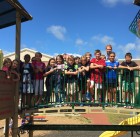
Happy Friday!
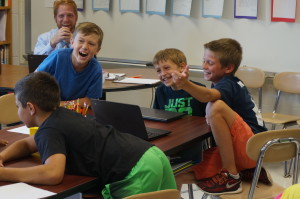 We have started off the year with three terrific days in room 209! The start of school can be a challenging transition for students, and Mr. Walmer and I have worked hard to make our classroom a welcoming community for all 22 new fourth graders. Of course, we did the usual activities with learning classroom routines, students attended their first music, library, Spanish, and wellness classes, and we participated in our school’s traditional first day bell-ringing ceremony. I’d like to take the opportunity to share with you four other activities we’ve been working on this week.
We have started off the year with three terrific days in room 209! The start of school can be a challenging transition for students, and Mr. Walmer and I have worked hard to make our classroom a welcoming community for all 22 new fourth graders. Of course, we did the usual activities with learning classroom routines, students attended their first music, library, Spanish, and wellness classes, and we participated in our school’s traditional first day bell-ringing ceremony. I’d like to take the opportunity to share with you four other activities we’ve been working on this week.
Social Contract
In lieu of class rules, we have worked together to brainstorm ways we want to be treated. Specifically, students answered four questions:
- How do we want to be treated by our teachers?
- How do our teachers want to be treated by us?
- How do we want to treat each other?
- How do we want to treat each other when there is a conflict?
In answering these questions, students generated lists of ideas that describe how we should treat others in the classroom. Some words/phrases, such as “respectfully” and “fairly” appeared as answers to multiple questions, so these will likely be emphasized in our final social contract (which I hope to finish early next week). The social contract is a terrific resource, because we all hold one another accountable to fulfill what we agree to do (when we all sign it.) So if a student is, for example, disturbing others during a lesson, I can refer back to the social contract by saying something like “Hey, Timmy, when you signed the social contract, you agreed to be helpful. When you’re making funny faces, are you helping your classmates to learn? You also promised to be respectful to others. I’ve asked you a few times to focus on the lesson, and I noticed that your friend asked you not to distract her as well. Are you respecting your friend and me when you keep doing that?” Using the social contract helps students to adjust their choices and see why poor choices affect others negatively, rather than just “getting in trouble.”
Chromebooks and Google Classroom
I love using technology in our classroom when it allows students to interact or think at a deeper level, when it makes some of our classroom processes more efficient, or when it is a motivator to students. Yesterday, students got their first opportunity of the year to work on Chromebooks and to log into our Google Classroom page. Kids completed an exercise to prepare for our Two Truths and a Lie activity (see below), and today, students started writing letters to their future selves (at the end of this year) about their goals, predictions, worries, and hopes for the year to come. I’ll share a lot more information with you in the coming weeks, but in the interest of clarity please note that (a) students should always share their Google login information with their grownups at home, and (b) students should NOT be using their school Google email accounts at all right now.
Two Truths and a Lie
Yesterday, students wrote th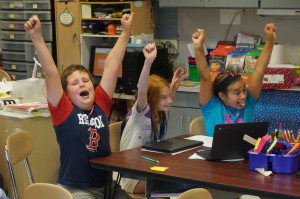 ree statements about themselves in a Google Doc activity; two of the statements were true, and one was a lie. Last night, I imported those statements into a game environment called Kahoot, which creates a quiz game based on the content I import. We played this game this afternoon, and the kids really
ree statements about themselves in a Google Doc activity; two of the statements were true, and one was a lie. Last night, I imported those statements into a game environment called Kahoot, which creates a quiz game based on the content I import. We played this game this afternoon, and the kids really 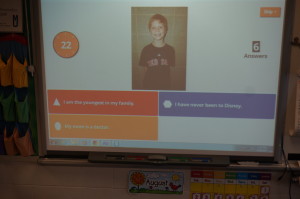 enjoyed learning more about their classmates in a fun and unique way! Plus, the gameshow-like interface of Kahoot created a friendly competition in our classroom. We’ll definitely use this tool more in the future!
enjoyed learning more about their classmates in a fun and unique way! Plus, the gameshow-like interface of Kahoot created a friendly competition in our classroom. We’ll definitely use this tool more in the future!
Readers’ Workshop
Reading lessons started on Thursday! In fourth grade, our reading instruction is inspired by Readers’ Workshop, which is an instructional philosophy that the best literacy instruction is delivered in small bundles, with plenty of opportunity to practice skills as a whole class, in small groups, and individually. Our lessons started with an introduction to our classroom library and book bins, and continued today with a lesson about what silent reading should look like and sound like.
Alliterative Adjective Greetings
You may have noticed that your son or daughter came home on Wednesday with an assignment to think of an adjective that either starts with the same letter as his or her first name and/or with the same sound as his or her first name. Today, students greeted their classmates at their table groups with their nicknames, and we added some challenge by asking students to race to pass around a foam ball while greeting their table-mates, sometimes while skipping around!
Posted in Class Updates|By Jon Moss
August 26, 2015
Parent Surveys for the New Year
Hello, families! Our first day is off to a terrific start, and I’m excited to get to know your kids better. Would you please take a few moments to complete TWO surveys for me? These help me to better target instruction to meet your child’s needs and to best address your goals. The first survey is a general survey that helps me to learn about your child. The second survey focuses on technology and will help me to understand more about your child’s access to and comfort with different forms of technology. Thank you for completing these at your earliest convenience. (I’d love to have them by Friday, if possible.) If you prefer to complete them on paper, please email me or send in a note, and I’ll print them for you.) The surveys are embedded below this paragraph. You do not need to complete both of them at once.
Posted in Class Updates|By Jon Moss

